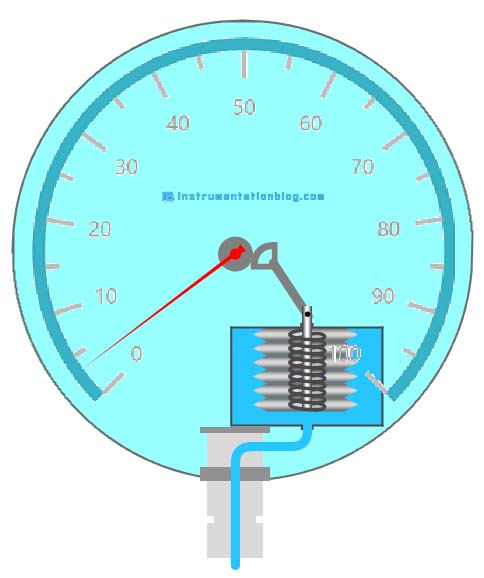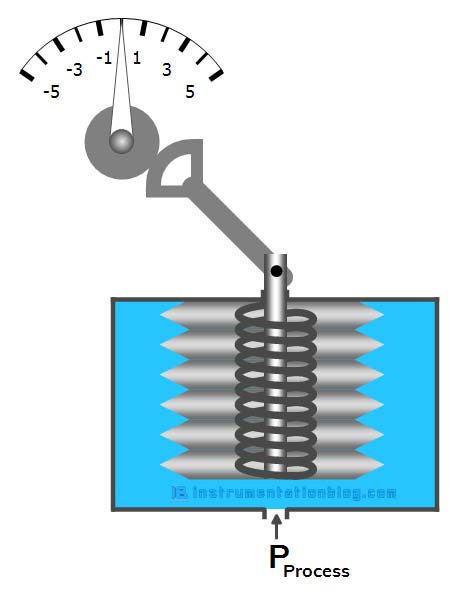Table of Contents
Bellow Pressure Gauge
Working Principle
The bellow type pressure gauge consists of thin-walled metallic discs with concertinaed sides to allow it to expand and contract, with one end closed and the other end remains open.
When the pressure is applied from the open side of the bellows, it expands the size of discs. The closed-end moves freely and the rod connected between the open end and the closed-end move upwards and rotate the pointer which will show the value of pressure.
Video Credit: I&C Channel
Bellow Construction and Characteristics
Most bellow gauges are spring-loaded. The spring opposes the bellow and preventing it from full expansion. The limiting of full expansion of the bellow protects it and prolongs its life.
In a spring-loaded bellow element, the deflection is the result of the force acting on the bellows and opposing the force of the spring.
General characteristics of the bellow pressure gauges are as below:
- The diameter may vary from 0.5 to 12 inches. A larger diameter means higher sensitivity and improvement of accuracy.
- The number of folds can vary between 5 to 20. More numbers of folds mean larger stroke length and they generate larger forces.
- The bellows may be fabricated from different materials such as Phosphor Bronze, Brass, Beryllium Copper, Stainless Steel, or other metals that are suitable for the intended purpose of the gauge.

Measuring Ranges
The measuring range of the bellow type pressure gauge mainly depends on the following factors,
- The effective area of the bellow
- Spring Gradient
- The material used to build a bellow
The primary application of the bellow type pressure gauge is the measurement of the low pressure or small differential pressure. Although some bellows instruments can be designed for measuring pressures up to 800 PSIG.
Bellow pressure gauges are used to measure all types of pressure such as relative pressure, absolute pressure, and differential pressure.
Relative Pressure Sensors
Relative pressure is measured with reference to the atmospheric pressure. Bellows have both the characteristics to expand and compress.
The bellows will generally be used in expansion when relatively low pressures are being measured. The process pressure acts inside the bellow and causes bellow to expand.
For the larger pressure, bellows will be used in compression. In this case, process pressure acts outside the bellow and causes bellow to compress. Bellows are generally being equipped with a heavy-duty spring for the larger pressure measurement.

Absolute Pressure Sensor
Absolute pressure is the pressure with reference to the perfect vacuum. The general arrangement to measure the absolute pressure requires two bellows, the first bellow is provided with the perfect vacuum and the second bellow is the measuring bellow.
These absolute pressure sensors are generally used to measure relative low pressure; it is not equipped with the calibrated spring mechanism. When the process pressure is applied to the second bellow it will expand and the deflection is transferred to the pointer needle via a mechanism.

Differential Pressure Sensor
Differential pressure can be measured with single bellow as well as dual bellow arrangement.
For the single bellow arrangement, we need to replace atmospheric pressure with the second process pressure in the below figure.
For the dual bellow arrangement as shown in the below figure, the low pressure is connected to the first bellow and the high pressure is connected to the second bellow. The difference of both the process pressure will be shown by the pointer.

For the higher pressure measurement bellows with smaller diameters are preferred, which are optionally provided with the internal and external spring mechanism.
The Differential Pressure Gauge Bellow-Diaphragm type construction can be used in aggressive environments with corrosive liquids or gases.
I hope you like this article about bellow pressure gauge, its working, construction, and types. If you have any feedback then please let us know in the comment section below.
Next Must-Read Articles,
- How does a Diaphragm Pressure Gauge work?
- What are the differences between sensor and transducer?
- How does a “Smart Transmitter” work?
- Bourdon Tube Pressure Gauge working principle.
- How does a Solenoid Valve work?
- Basic study of Industrial Pressure Measurement.
You can read more articles about Electrical and you can also find books that boost your knowledge in the field of Instrumentation ⇒
Thanks for reading!
